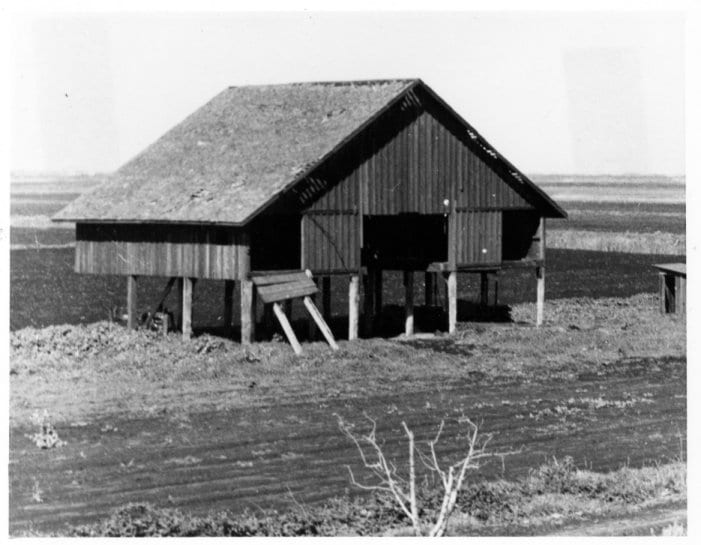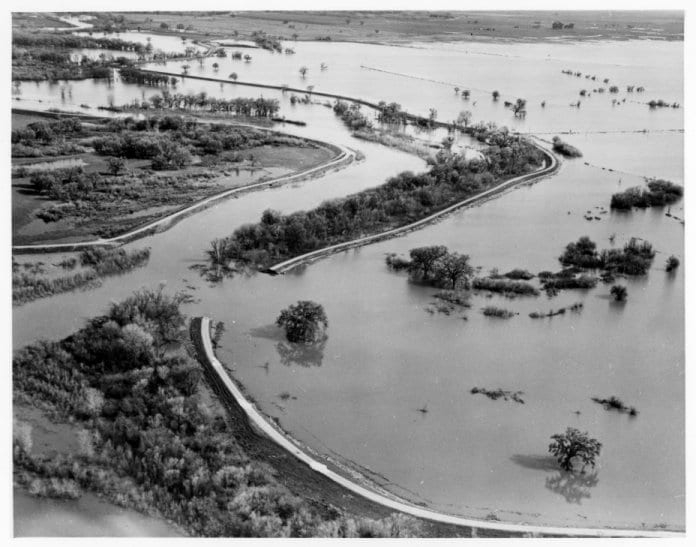The Ground Beneath Our Feet: The Nikola P. Prokopovich Papers on Land Subsidence
Exhibit Details
Dr. Nikola P. Prokopovich (1918-1999) was born in Kiev, Ukraine and came to the United States in 1950. He made his home in Sacramento, where he worked as a geologist with the Bureau of Reclamation’s Mid-Pacific Region. Dr. Prokopovich worked out of the Sacramento office from 1958-1986, investigating the geology and geochemistry of California statewide water projects, including the Central Valley Project and the Solano Project. Because of the wide-ranging impact of the Central Valley Project, the Prokopovich papers will be of interest to a number of disciplines: geology; environmental science and policy; water science; soil science; and history, especially history of agriculture.

Nikola P. Prokopovich Papers: Nikola Prokopovich in a tributary wash, ca. 1950

Nikola P. Prokopovich Papers: Prokopovich at East Bay Aqueduct showing change in ground level, ca. 1960

Nikola P. Prokopovich Papers: Nikola Prokopovich with sandstone boulder, ca. 1960
Prokopovich was an avid field geologist and spent as much time as possible on-site, collecting his own data. He was particularly interested in the engineering geology of the Central Valley Project’s canals and dam sites and in the effects of both the state water projects and field irrigation on the surrounding landscape. The collection includes draft reports, memoranda, and published writings, as well as nearly 25,000 slides and photographs documenting his work and the land around his work sites.

Nikola P. Prokopovich Papers: Sample pages from Prokopovich’s notebooks

Nikola P. Prokopovich Papers: Sample pages from Prokopovich’s notebooks

Nikola P. Prokopovich Papers: Sacramento Valley from the air
The Central Valley Project
The Central Valley Project (CVP) is a Bureau of Reclamation federal water project designed to provide irrigation and municipal water to California’s Central Valley. Reservoirs in the northern half of the state regulate and store water and a series of canals, aqueducts, and pump plants transport it to the San Joaquin Valley and its surroundings.
Source:
http://en.wikipedia.org/wiki/Central_Valley_Project

Nikola P. Prokopovich Papers: Map of the Central Valley Project

Nikola P. Prokopovich Papers: Shasta Dam Courtesy of the US Bureau of Reclamation

Nikola P. Prokopovich Papers: San Luis Dam and Reservoir Courtesy of the US Bureau of Reclamation

Nikola P. Prokopovich Papers: Two views of Folsom Dam Courtesy of the US Bureau of Reclamation

Nikola P. Prokopovich Papers: Two views of Folsom Dam Courtesy of the US Bureau of Reclamation

Nikola P. Prokopovich Papers: San Joaquin Valley from the air
Subsidence
Land subsidence occurs when large amounts of ground water have been withdrawn from certain types of rocks, such as fine-grained sediments. The rock compacts because the water is partly responsible for holding the ground up. When the water is withdrawn, the rock falls in on itself.
Source:
http://ga.water.usgs.gov/edu/earthgwlandsubside.html

Nikola P. Prokopovich Papers: Cost of Subsidence to the Central Valley Project, CA by Prokopovich, N.P., and Marriott, M.J., 1983

Nikola P. Prokopovich Papers: Shrinkage cracking in mud

Nikola P. Prokopovich Papers: Four examples of subsidence

Nikola P. Prokopovich Papers: Soil cracking and slumpage, ca.1970

Nikola P. Prokopovich Papers: Open crack at Clear Lake, ca. 1965
Subsidence in Delta Peat

Nikola P. Prokopovich Papers: Schematics for a compaction recorder

Nikola P. Prokopovich Papers: Compaction recorder in use, ca. 1965

Nikola P. Prokopovich Papers: Subsidence at Byron Tract. Note the difference in ground level on the left and right sides of the levee.

Nikola P. Prokopovich Papers: Holland Tract, near Sacramento. This barn was originally built level to the ground. Courtesy of the State of California Department of Water Resources

Nikola P. Prokopovich Papers: Sherman Island floodwaters, ca. 1980 Courtesy of the US Army Corps of Engineers
Hydrocompaction
Hydrocompaction is the settling and hardening of land due to application of large amounts of water for irrigation.
Source:
http://www.epa.gov/climatechange/glossary.html

Nikola P. Prokopovich Papers: Damage to irrigation ditch due to hydrocompaction

Nikola P. Prokopovich Papers: Damage to Mendota Test Canal lining due to hydrocompaction, ca. 1965

Nikola P. Prokopovich Papers: Core samples from Latrobe Dam site. Understanding the properties of the surrounding soil is crucial for dam safety.

Nikola P. Prokopovich Papers: “Several homes are already cracking and tilting because of severe land subsidence…One home, built only three years ago, has large cracks in the master bedroom, kitchen, living room, and hall. The crack in the bedroom is an inch wide and goes across the ceiling and down one wall, exposing insulation.” Fresno […]

Nikola P. Prokopovich Papers: “Shallow subsidence of from 5-6 feet should be expected at the site… The subsidence will be particularly severe because in the past the area has had very little irrigation.” Memorandum from Prokopovich’s files, 1967 (pg.1)

Nikola P. Prokopovich Papers
Monitoring the Environment

Nikola P. Prokopovich Papers: Canal sampling is done to gauge ecosystem health and to measure organisms’ impact on canal capacity.

Nikola P. Prokopovich Papers: Post-dewatering sampling in Delta-Mendota Canal, ca. 1970

Nikola P. Prokopovich Papers: Delta-Mendota Canal ecological sampling data

Nikola P. Prokopovich Papers: Organic Life, Particularly Asiatic Clams, in the Delta Mendota Canal, Central Valley Project, California

Nikola P. Prokopovich Papers: Salt crust in irrigation ditch. Salt deposits are left by chemical fertilizers and by the salts naturally present in water. These deposits have a major effect on the water supply downstream.

Nikola P. Prokopovich Papers: Copper sampling in Lake Solano. These studies investigated the aftereffects of mining: what residues are in our water?
Processing of the Nikola P. Prokopovich Papers was generously funded by the Andrew W. Mellon Foundation, and administered by the Council on Library and Information Resources (CLIR). The University of California, Davis Special Collections was awarded a Cataloging Hidden Special Collections and Archives grant from 2010-2012, “Uncovering California’s Environmental Collections,” in collaboration with eight additional special collections and archival repositories throughout the state and the California Digital Library (CDL). Grant objectives included processing of over 33 hidden collections related to the state’s environment and environmental history. The collections document an array of important sub-topics such as irrigation, mining, forestry, agriculture, industry, land use, activism, and research. Together they form a multifaceted picture of the natural world and the way it was probed, altered, exploited and protected in California over the twentieth century. Finding aids are made available through the Online Archive of California.
Images (unless otherwise credited) are the property of the Regents of the University of California; no part may be reproduced or used without permission of the Department of Special Collections.